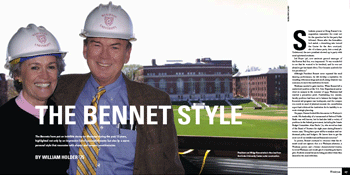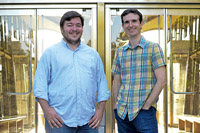The Bennet Style
 Students present at Doug Bennet’s inauguration remember the event not for the speeches but for the party that followed. Hours after the formalities had ended, a drenching rain turned the Center for the Arts courtyard, site of a dance party, into a mud pit. Undeterred, the new president showed up to party with mud-splattered students.
Students present at Doug Bennet’s inauguration remember the event not for the speeches but for the party that followed. Hours after the formalities had ended, a drenching rain turned the Center for the Arts courtyard, site of a dance party, into a mud pit. Undeterred, the new president showed up to party with mud-splattered students.
Jed Hoyer ’96, now assistant general manager of the Boston Red Sox, was impressed. “It was wonderful to see that he wanted to be involved, and he was not afraid to get his hands dirty. That became symbolic for his presidency.”
Although President Bennet never repeated his mud dancing performance, he did develop a reputation for wrestling with issues large and small, doing whatever was necessary to move the institution forward.
Wesleyan needed to gain traction. When Bennet left a senior-level position at the U.S. State Department and arrived on campus in the summer of 1995, Wesleyan had reached a precarious point. Fundraising was anemic, faculty positions had been cut to balance the budget, the financial aid program was inadequate, and the campus was sorely in need of physical renewal. An accreditation report had criticized the institution for its inability to execute strategic planning.
On paper, Bennet looked like the answer to Wesleyan’s needs. His leadership of a turnaround at National Public Radio was well known, but he had also held a variety of positions in the federal government, including the Senate Budget Committee. Alan Dachs ’70, who served as chair of the Board of Trustees for eight years during Bennet’s tenure, says, “Doug has a great ability to analyze and understand policy and budgets. He knows how to get the most out of our intellectual and financial resources.”
In person, Bennet conveyed to everyone what his resume could not capture: that as a Wesleyan alumnus, a Wesleyan parent, and a former alumni-elected trustee, he loved Wesleyan and would give it everything he had to give. Students sensed his joy in being president when they danced in the mud with him.
Bennet wasted no time in getting started. Barbara-Jan Wilson, vice president for university relations, recalls: “Doug began moving us forward by something very simple. He said let’s make sure the washing machines work; let’s do the fix-its. We had a list of fix-its, and at every senior staff meeting on Tuesday mornings, we checked off the fix-its. Were letters to alumni addressed to the right alumni? That sort of thing.”
The small fix-its led to some large fix-its, such as redesigning the computerized course preregistration system so that it delivered students more courses they wanted and less angst. Throughout the fix-it phase Bennet made it clear that he would hold himself and administrative staff members to high standards.
At the same time, he started a series of conversations with the entire Wesleyan community, but with special attention to faculty, about the purpose of a Wesleyan education. The conversations led to a substantial set of papers on the future of liberal arts education produced by faculty and others. Out of this Bennet fashioned “Wesleyan Education for the 21st Century,” the central strategy document for his administration. It is the accomplishment that he considers to be most significant during his tenure because it lays out a rationale for the kind of education Wesleyan offers.
As he told Anna Quindlen, “We asked how you define a curriculum these days. The answer is that you don’t have a set curriculum with Greek history, but there is a way to decide what capabilities people need when they leave here, so the whole curriculum is being reorganized to reflect those capabilities. The theory is that you can study almost anything as long as you are picking up these capabilities. Russian history might be as good for ethics as anything else.”
Joseph Bruno, vice president for academic affairs and a longtime member of the chemistry department, believes that the capabilities are an invaluable tool for faculty and students.
The capabilities “differ entirely from more traditional distribution expectations or major requirements,” he says. “Rather, they constitute those skills the faculty believe our students should master during their Wesleyan education. Numerous faculty committees have worked diligently to identify and define the capabilities, and to establish the characteristics of courses that provide students with them.”
As the strategy document took shape, Bennet’s leadership style was becoming more apparent. Individuals working with him observed the way in which he worked an issue, probing every aspect of it, seeking to understand the players, not letting go until he was satisfied with his comprehension of whatever was driving it.
Common threads quickly emerge when people are asked to reflect on Bennet’s leadership style. He has liked large, complex problems. He has been consultative and never hesitated to reach out to obtain diverse points of view. He has often been funny and gracious, as well as challenging and stubborn. He has listened attentively and has welcomed a well-reasoned argument. He has placed great emphasis on process, believing that sound process produces sustainable decisions.
Jim Dresser ’63, chair of the Board, was struck by Bennet’s instincts. “He always seemed to know when to let the debate roll, when to intervene decisively, whom to consult with, under what circumstances to talk to different constituencies, when to delegate, when not to delegate. I learned to appreciate his emphasis on writing, coherent writing (preferably without split infinitives), because I was reminded that so often unclear writing masks unclear thinking.”
His conversations with faculty about Wesleyan’s academic mission laid the groundwork for what many soon saw as a positive, productive relationship. “Very early on,” says Bruno, “people began to realize that this was a guy who believed in the institution, believed in what the faculty were trying to do, and was confident we could achieve gains we hadn’t achieved in years.”
Bennet differed from his recent predecessors in the Wesleyan presidency in that he was a Connecticut native who had grown up near the mouth of the Connecticut River in a politically engaged family. That connection helped him establish relationships throughout the state, which proved to be highly beneficial when Wesleyan sought to acquire 165 acres of state property adjacent to the campus, used for a juvenile correctional facility. Wesleyan’s success in this venture was far from assured. The state was proposing to build a new, higher security facility on the same site. Only through diligent effort over a period of years and the assistance of numerous individuals capable of influencing the state’s decision did Wesleyan succeed in purchasing the property for $16 million.
Bennet sought other ways for Wesleyan to engage in an ongoing partnership with Middletown. Wesleyan became a participant in the Main Street USA program, thereby helping the city coordinate efforts to improve the downtown area. The university made a significant financial investment in the Inn at Middletown, a modern, attractive hotel on the south end of Main Street that has enabled Wesleyan to host guests comfortably.
The university’s largest off-campus project in Middletown by far has been the Green Street Arts Center. Wesleyan led the creation, staffing, and fundraising for this facility in the city’s North End. It provides an important cultural resource for the city, but also an anchor for the rehabilitation of this economically advancing area only a few blocks from campus.
“None of this would have happened without Doug’s leadership,” says Peter Patton, vice president and secretary of Wesleyan, “but he said right from the beginning, ‘Let’s do this in a grass roots way. Let’s work with community members to find out what they want and what we can give.’ I think it is a durable relationship, built on mutual respect.”
No university president meets with universal acclaim, and Bennet faced some difficult controversies. Early in his tenure, he relieved the chair of the dance department of her duties over a personnel matter and weathered intense criticism from her loyal supporters, including a small plane trailing a “Fire Bennet” banner at that year’s Commencement. A newspaper story about a pornography course unleashed a storm of national publicity and radio talk show criticism. Controversy over the use of sidewalks for chalking messages was settled after discussion about the complementary principles of protecting free expressions and, at the same time, enhancing Wesleyan’s civility. Through these controversies and others, Bennet has sought to find what he sees as a principled stand and then move on, always returning to the principles of academic excellence and civility.
With the strategic plan in place and a growing sense that Wesleyan was regaining its momentum, Bennet and the trustees were able to launch a highly ambitious fundraising effort. Consultants had told Wesleyan it would be lucky to raise much more than $100 million, but Bennet and the Board had far higher aspirations of $225 million. Buoyed by early successes, they soon raised the goal to $250 million. Even after the stock market collapsed with the technology implosion and fundraising became harder, Wesleyan persevered with its ambitious goal. When the campaign closed on December 31, 2004, at $281 million, Wesleyan had entered a new era.
The campaign supported extensive physical renewal of the campus, which will be the most tangible aspect of Bennet’s legacy (see p. 31). It also raised about $100 million for financial aid, which was critical to Wesleyan’s continued success in admissions. Shola Olatoye ’96, who knew Bennet when she was a student and later as an alumni-elected trustee, cites this accomplishment as particularly important:
“Doug has continued the tradition of need-blind, therefore ensuring access for all qualified students. I think it is a no-brainer for him because it’s what the modern Wesleyan is all about. He realizes that some people make great sacrifices to send their children to this school, and I think he feels a responsibility to those families.”
The campaign invigorated virtually every aspect of the campus. Through it, Wesleyan expanded the size of the faculty and renovated nearly every classroom with attractive furnishings and appropriate technology. Wesleyan substantially enhanced its physical plant, from a major addition to Freeman Athletic Center on the southern end of campus to the exquisite, award-winning Center for Film Studies on the northern side. The opening of the Suzanne Lemberg Usdan University Center and the renovated Fayerweather Gymnasium, scheduled for fall of the 2007-08 academic year, will cap the Bennet presidency with its largest, most ambitious project.
“Doug has brought a new way of looking at facilities,” says Wilson. “First, you look at restoration, and you decide what you are going to do to make every building the best that it can be. Then you figure out what new buildings you need to be competitive.”
The campaign transformed giving at Wesleyan. When Bennet became president, 36 percent of alumni participated in annual giving. Ten years later, that number is 54 percent. On an annual basis, Wesleyan is raising three times as much money as it did in 1995. This support from alumni and parents has carried beyond the campaign. In the first year after the campaign closed, Wesleyan raised $35 million, more than in any year of its history.
Wesleyan’s endowment almost doubled during the Bennet presidency, going from a market value of $345 million at the outset to $631 million on March 31, 2006. Bennet streamlined the processes for making investment decisions and established Wesleyan’s first dedicated investment staff. He set an objective of reaching top quartile investment returns, as compared to Wesleyan’s peer institutions, and achieved it. At the close of his administration, he is leading efforts to reduce Wesleyan’s budgetary reliance on its endowment and to increase the proportion of new gifts that are invested in the endowment.
Confidence and optimism imbue Wesleyan today. Kofi Appenteng ’81, an emeritus trustee and Wesleyan parent, reflects the view of many by saying, “I would define the Bennet era as one where Wesleyan regained its footing, regained its confidence, and started to see the possibilities rather than the problems.”
That view comes from individuals who are well aware of the challenges facing Wesleyan. Chief among those is that nearly all of Wesleyan’s peer institutions have endowment-per-student ratios much higher than Wesleyan’s. As a result, maintaining Wesleyan’s competitive position on a range of measures—admissions, financial aid, faculty resources, and endowment growth—will present the next administration with ample opportunity for hard work. Wesleyan urgently needs a new science building, the cost of which will easily top $100 million. The pace of fundraising cannot slow down.
The president’s office in South College soon will have a new occupant, but that person will benefit greatly from the accomplishments of the Bennet era. As Bruno says, “Doug has been able to establish a momentum at Wesleyan that is going to carry us forward for years and years to come.”


